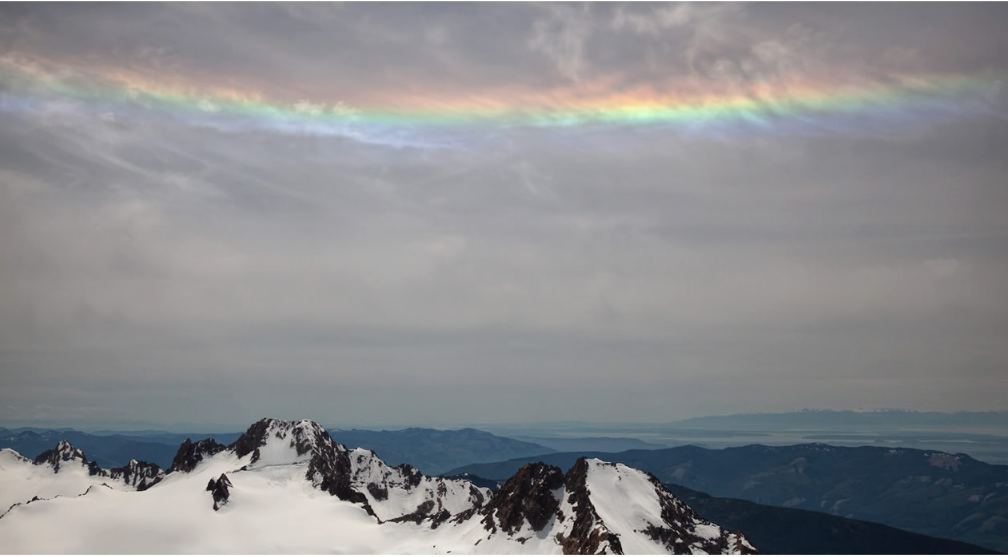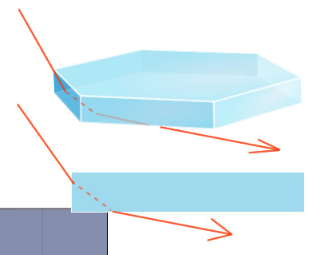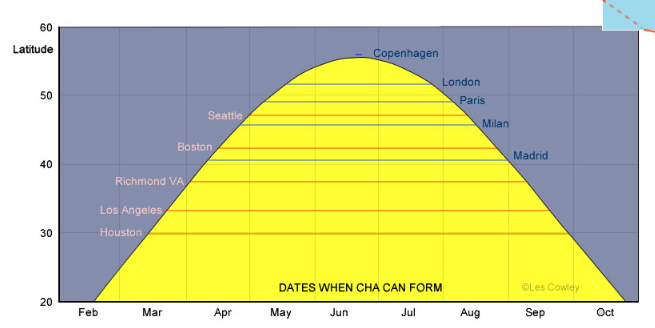OPOD - Twin Sisters Range Circumhorizon Arc
Twin Sisters Range Circumhorizon Arc: A Spectacular Atmospheric Phenomenon
Have you ever witnessed a breathtaking atmospheric phenomenon that seems like a painting in the sky? The Twin Sisters Range Circumhorizon Arc is one such spectacle that can leave you in awe. This captivating optical phenomenon was beautifully captured by John Scurlock of Mountain Aerial Photography, while flying near the Twin Sisters Range east of Bellingham, Washington. The image he captured showcases the sheer immensity of the halo, which can stretch an astonishing 90° or more around the horizon.
The Twin Sisters Range Circumhorizon Arc is a type of ice halo that appears during the summer months when the sun is higher than approximately 58° in altitude. This specific angle allows rays of sunlight to enter the side faces of horizontal plate crystals and exit through the bottom hexagonal face. The refraction of light through these crystals, which essentially act as prisms, results in widely separated and pure spectral colors. As a result, the Twin Sisters Range Circumhorizon Arc displays a stunning array of vibrant hues.
When the sun is lower than 58°, the rays of sunlight cannot leave the lower face of the crystals. Instead, they internally reflect and eventually emerge, creating other atmospheric phenomena such as a white parhelic circle or sundogs. It is fascinating how the position of the sun in the sky can influence the appearance of these beautiful optical phenomena.
While the Twin Sisters Range Circumhorizon Arc may be fairly common in North America, it is less frequently observed by viewers in mid to northern Europe due to the lower position of the sun. This rarity makes it even more special for those lucky enough to witness this extraordinary display of nature.
In addition to its visual appeal, the Twin Sisters Range Circumhorizon Arc serves as a reminder of the complex interactions between light and ice crystals in our atmosphere. Understanding these interactions can help scientists gain insights into the composition and behavior of atmospheric particles, as well as the broader field of atmospheric optics.
To fully appreciate the Twin Sisters Range Circumhorizon Arc and other similar atmospheric phenomena, it is crucial to embrace the wonders of nature and keep an eye on the sky. These awe-inspiring displays serve as a reminder of the beauty and intricacy of our natural world.
In conclusion, the Twin Sisters Range Circumhorizon Arc is a remarkable optical phenomenon that showcases the magic of light interacting with ice crystals in the atmosphere. Its vibrant colors and expansive appearance make it a truly breathtaking sight. While it may be more common in North America, viewers in other parts of the world can still be treated to this extraordinary display under specific conditions. So, keep your eyes peeled and be ready to witness the wonders that nature has in store for us.

Twin Sisters Range Circumhorizon Arc - John Scurlock ( Mountain Aerial Photography ) pictured the scene while he was flying near the Twin Sisters Range east of Bellingham, Washington. The camera looks to the south/southwest towards Puget Sound. John has captured the sheer immensity of the halo which can stretch 90° and more around the horizon.
©John Scurlock, shown with permission.

This summer only ice halo requires the sun to be higher than ~58°. Above that altitude, rays can enter the side faces of horizontal plate crystals and leave through the bottom hexagonal face. The refraction through what is essentially a 90 degree prism gives widely separated and pure spectral colours.
Lower the sun and the rays cannot leave the lower face. Instead they internally reflect and eventually emerge to make a white parhelic circle, a sundog or some other halo.

North American viewers should count their blessings for the halo is fairly common there although most often seen only as a fragment.
Mid to northern Europeans see it far less often because the sun is lower.
Note: this article has been automatically converted from the old site and may not appear as intended. You can find the original article here.
Reference Atmospheric Optics
If you use any of the definitions, information, or data presented on Atmospheric Optics, please copy the link or reference below to properly credit us as the reference source. Thank you!
-
<a href="https://atoptics.co.uk/blog/opod-twin-sisters-range-circumhorizon-arc/">OPOD - Twin Sisters Range Circumhorizon Arc</a>
-
"OPOD - Twin Sisters Range Circumhorizon Arc". Atmospheric Optics. Accessed on November 26, 2024. https://atoptics.co.uk/blog/opod-twin-sisters-range-circumhorizon-arc/.
-
"OPOD - Twin Sisters Range Circumhorizon Arc". Atmospheric Optics, https://atoptics.co.uk/blog/opod-twin-sisters-range-circumhorizon-arc/. Accessed 26 November, 2024
-
OPOD - Twin Sisters Range Circumhorizon Arc. Atmospheric Optics. Retrieved from https://atoptics.co.uk/blog/opod-twin-sisters-range-circumhorizon-arc/.